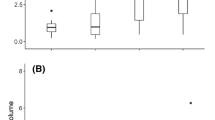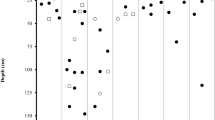Abstract
Like many ants inhabiting temperate regions, leaf-cutting ant colonies of a number of Acromyrmex species build thatched nests that achieve more stable temperatures than those of the environment. Workers are expected to counteract short-term variations in nest microclimate by modifying the thatch structure, for instance by reducing thatch thickness or by permeating the thatch with openings so as to favor heat exchanges with the outside. Such thermoregulatory responses may compromise the control of nest humidity because of the concomitant water losses resulting from the escape of humid air to the environment. We asked whether water losses through the thatch trigger deposition of nest material as a regulatory response for humidity control. In a laboratory colony of A. heyeri, we defined four equidistant spots on the nest thatch through which losses of air with different humidities were experimentally simulated. The deposition of building material on the spot was recorded as indicative building response. Results showed that material deposition occurred significantly more frequently with higher humidity content of the air leaving the spot. Dry air leaving the nest hardly triggered material deposition. The observation of a continuous turnover of thatch material indicates that the building of a nest thatch is a permanent process, and that short-term responses for the control of nest climate, as the deposition of building material to suppress an outflow of humid air, are guided by specific cues such as the humidity content of the air stream.




Similar content being viewed by others
References
Bollazzi M., Kronenbitter J. and Roces F. 2008. Soil temperature, digging behaviour, and the adaptive value of nest depth in South American species of Acromyrmex leaf-cutting ants. Oecologia 158: 165-175
Bollazzi M. and Roces F. 2007. To build or not to build: circulating dry air organizes collective building for climate control in the leaf-cutting ant Acromyrmex ambiguus. Anim. Behav. 74: 1349-1355
Bollazzi M. and Roces F. 2010a. Leaf-cutting ant workers (Acromyrmex heyeri) trade-off nest thermoregulation for humidity control. J. Ethol. DOI 10.1007/s10164-010-0207-3
Bollazzi M. and Roces F. 2010b. The thermoregulatory function of thatched nests in the South American grass-cutting ant Acromyrmex heyeri. J. Ins. Sci. (in press)
Bonetto A.A. 1959. Las hormigas “cortadoras” de la provincia de Santa Fé (Géneros: Atta y Acromyrmex). Ministerio de Agricultura y Ganaderia, Provincia de Santa Fe, Argentina. 77 pp
Camazine S., Deneubourg J., Franks N.R., Sneyd J., Theraulaz G. and Bonabeau E. 2001. Self-Organization in Biological Systems. New Jersey: Princeton University Press. 525 pp
Cengel Y.A. 2003. Heat Transfer. A Practical Approach. USA: Mc Graw-Hill
Diehl-Fleig E. and Droste A. 1992. Localizaçâo, morfologia externa e flutuações populacionais ao longo do ano de colônias de Acromyrmex heyeri (Hymenoptera: Formicidae). Ann. Soc. Entomol. Brasil 21: 21-22
Farji-Brener A.G. 2000. Leaf-cutting ant nests in temperate environments: mounds, mound damages and nest mortality in Acromyrmex lobicornis. Stud. Neotrop. Fauna Environ. 35: 131-138
Fowler H.G., Pereira-da-Silva V., Forti L.C. and Saes N.B. 1986. Population dynamics of leaf-cutting ants: A brief review. In: Fire Ants and Leaf-Cutting Ants - Biology and Management (Lofgren C.S. and Vander Meer R.K., Eds), Boulder: Westview Press. pp 123-145
Fowler J., Cohen L. and Jarvis P. 1998. Practical Statistics for Field Biology. John Wiley & Sons. 259 pp
Frouz J. 2000. The effect of nest moisture on daily temperature regime in the nests of Formica polyctena wood ants. Insect. Soc. 47: 229-235
Frouz J. and Finer L. 2007. Diurnal and seasonal fluctuations in wood ant (Formica polyctena) nest temperature in two geographically distant populations along a south–north gradient. Insect. Soc. 54: 251-259
Hansell M. 2005. Animal Architecture. Oxford: Oxford University Press. 334 pp
Hillel D. 1998. Environmental Soil Physics. London: Academic Press. 771 pp
Horstmann K. and Schmid H. 1986. Temperature regulation in nests of the wood ant, Formica polyctena (Hymenoptera: Formicidae). Entomol. Gen. 11: 229-236
Jonkman J.C.M. 1980. The external and internal structure and growth of nests of the leaf-cutting ant Atta vollenweideri Forel, 1893 (Hym.: Formicidae). Part II. The internal nest structure and growth. Z. ang. Entomol. 89: 217-246
Kloft W. 1959. Zur Nestbautätigkeit der roten Waldameisen. Waldhygiene 4: 94-98
Korb J. 2003. Thermoregulation and ventilation of termite mounds. Naturwissenschaften 90: 212-219
Leite P.R.G. 1995. Plasticidade na solução de problemas de perda de umidade em colônias de Atta sexdens Forel, 1908: forrageamento e construção. In: Doctoral Thesis, Department of Psicology, University of São Paulo, Brasil, University of São Paulo. pp 124
McCook H.C. 1879. On the architecture and habits of the cutting ant of Texas (Atta fervens). Ann. Mag. Nat. Hist. 3: 442-449
Powell R.J. and Stradling D.J. 1986. Factors influencing the growth of Attamyces bromatificus, a symbiont of attine ants. Trans. Br. Mycol. Soc. 87: 205-213
Ribeiro P.L. and Navas C.A. 2008. Colony dehydration and water collection by specialized caste in the leaf-cutting ant Atta sexdens rubropilosa. J. Insect. Behav. 21: 549-558
Roces F. and Kleineidam C. 2000. Humidity preference for fungus culturing by workers of the leaf-cutting ant Atta sexdens rubropilosa. Insect. Soc. 47: 348-350
Seeley T.D. 1995. The Wisdom of the Hive. Cambridge, Massachussets: Harvard University Press. 295 pp
Seeley T.D. and Heinrich B. 1981. Regulation of temperature in the nest of social insects. In: Insect Thermoregulation (Heinrich B., Ed), New Jersey: John Wiley and Sons, Inc. pp 160-234
Smith C.R. and Tschinkel W.R. 2005. Object depots in the genus Pogonomyrmex: Exploring the “who,” what, when, and where. J. Insect Behav. 18: 859-879
Sudd J.H. 1982. Ants: foraging, nesting, brood behavior, and polyethism. In: Social Insects (Hermann H.R., Ed), New York: Academic Press. pp 107-155
Sudd J.H. and Franks N.R. 1987. The Behavioural Ecology of Ants. Glasgow: Blackie & Son Limited. 220 pp
Theraulaz G. and Bonabeau E. 1999. A brief history of stigmergy. Artif. Life 5: 97-116
Theraulaz G., Bonabeau E. and Deneubourg J. 1998. The origin of nest complexity in social insects. Complexity 3: 15-25
Theraulaz G., Bonabeau E., Nicolis S.C., Solé R.V., Fourcassié V., Blanco S., Fournier R., Joly J.-L., Fernández P., Grimal A., Dalle P. and Deneubourg J.-L. 2002. Spatial patterns in ant colonies. Proc. Natl Acad. Sci. USA 99: 9645-9649
Turner J.S. 2000. The Extended Organism - The Physiology of Animal-built Structures. Cambridge: Harvard University Press. 235 pp
Weber N.A. 1972. Gardening Ants - The Attines. Philadelphia: The American Philosophical Society. 146 pp
Zolessi L.C. and González L.A. (1974) Nidificación y mesoetología de Acromyrmex en el Uruguay. II. Acromyrmex (Acromyrmex.) lobicornis (Emery, 1887). (Hymenoptera: Formicidae). Rev. Biol. Urug. 1: 37-57
Acknowledgments
We thank two anonymous reviewers for thoughtful comments that helped improve the manuscript. This research was supported by funds from the German Research Council (DFG, Grant SFB 554/TP E1) and the German Academic Exchange Service (DAAD, PhD fellowship granted to MB). We also thank Jenja Kronenbitter and Silvia Cardozo for their help with the video counts, and Annette Laudahn and Adrienne Gerber Kurz for the care of the A. heyeri colony.
Author information
Authors and Affiliations
Corresponding author
Rights and permissions
About this article
Cite this article
Bollazzi, M., Roces, F. Control of nest water losses through building behavior in leaf-cutting ants (Acromyrmex heyeri). Insect. Soc. 57, 267–273 (2010). https://doi.org/10.1007/s00040-010-0081-6
Received:
Revised:
Accepted:
Published:
Issue Date:
DOI: https://doi.org/10.1007/s00040-010-0081-6




